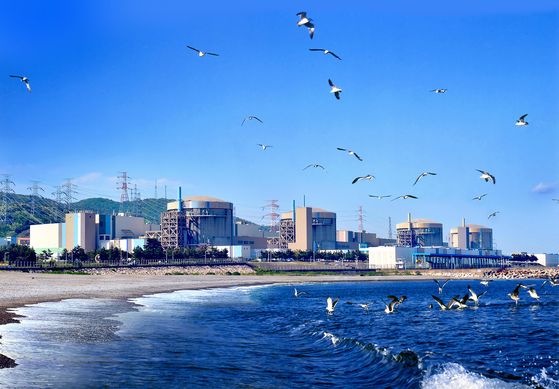
There is a possibility of external leakage due to the high concentration of tritium coming from the inside of Wolseong Nuclear Power Plant #3. The photo is Wolseong nuclear power plant. yunhap news
Suspicions have been raised that radioactive materials far exceeding the standard were released from the Wolseong nuclear power plant and leaked to the outside. The ruling Democratic Party and the ruling party added to the suspicion raised by environmental groups and some media, sparking the inevitable theory of the Wolseong nuclear power plant shutdown. However, Han Suwon and some experts contend with this “inflated argument.” I looked into the facts to see who was right.
① Emission of radioactive substances above the standard value?
What sparked the controversy was the deceased person found in the manhole of the 3rd Wolseong nuclear power plant in April last year. Looking at the current status and action plan for the management of groundwater tritium in the Wolseong nuclear power plant site, prepared by Korea Hydro & Nuclear Power at the time, the amount of 713,000 Bq (becquerel) per liter from the water accumulated in the manhole of the lower groundwater drainage ditch (turbine gallery) of the Wolseong unit 3 Tritium was detected. It is 17.8 times higher than the emission standard of 40,000 Bq/L.
Tritium is a kind of waste produced when a heavy water reactor type nuclear power plant is operated, and it can be harmful to humans in case of excessive exposure, so discharges are strictly managed. Some environmental groups have raised suspicion of external tritium leakage based on the accumulated water. As high concentration tritium came out of a place other than the outlet, it is highly likely that it flowed into groundwater.
However, strictly speaking, there is currently no evidence that this tritium has gone out. There are a total of 7 manholes in the groundwater drainage channel of Wolseong Unit 3 that act as a reservoir. During the dry season, water usually accumulates here, and when the groundwater rises, it goes out through a drain. The place where tritium above the standard level came out is water that was still accumulated in manhole 2 before being discharged to the outside.
Wonheung University’s Wolseong Nuclear Power Plant Headquarters said, “The actual discharge to the outside and the water accumulated in the structure in the power plant management area are different concepts. This time, the stored water from which the high concentration of tritium was released is of course collected and disposed of in liquid waste storage,” he explained. The groundwater that goes out through the outlet is also regularly inspected on a monthly basis.
② Radioactivity was leaked due to old facilities of nuclear power plant?
There were also suspicions that tritium above the standard was discharged from the old Wolseong nuclear power plant.
In fact, Nak-yeon Lee, representative of the Democratic Party, said at the party’s highest committee meeting held on the 11th, “It was confirmed again that the shutdown of the Wolseong nuclear power plant was inevitable due to the aging of the facility.” It was truly an irresponsible political battle,” he said, making the possibility of leakage due to obsolete facilities.
However, the possibility of radioactive material being released from the facility is so far slim. If a pipe crack leaks radioactive material, in addition to tritium, other materials such as cesium and cobalt must be detected. KHNP said, “No substances other than tritium were detected in the 27 wells or drainage manholes made to check for groundwater leakage, and the detected tritium was also below the standard.”
It is also possible that tritium with small particles permeated the outer wall of the facility and was discharged. However, KHNP believes that there is a high possibility that the tritium in the air inside the nuclear power plant was adsorbed to the stagnant water. However, it was decided to request an external agency to investigate the specific cause.
③ Are residents around the nuclear power plant contaminated with groundwater?
If tritium is actually leaked, check the concentration of groundwater and the amount of exposure of nearby residents. However, according to the KHNP survey, the contamination of tritium groundwater and the exposure of nearby residents were very slight.
KHNP built wells called Gwanjeongs in four locations outside the nuclear power plant (Bonggil, Nasan, Ulsan, and Gyeongju) to monitor external leakage. Here, groundwater is inspected quarterly to check for radioactive material leaks. As a result of the KHNP survey in October last year, the only place where tritium came out of the four wells was in the Bonggil area near the Wolseong nuclear power plant. The International Health Organization (WHO) drinking water standard allowed for tritium is 10,000 Bq/L. The tritium from the Bongil area was also insignificant at 4.08 Bq/L.
The amount of exposure of nearby residents also did not come up with a problem. As a result of the KHNP’s investigation of the exposure of nearby residents between 2018 and 2020, the maximum concentration of tritium in the body was 16.3 Bq/L, similar to the amount ate 3.4 bananas.
Professor Jeong Yong-hoon of KAIST’s Department of Nuclear and Quantum Engineering said, “Assuming the worst situation, even if all the high-concentration tritium found inside the Wolseong nuclear power plant leaked to the outside, it should not be a problem at all because the total amount is small.” “There was no problem in the investigation of the amount of exposure to the body, so I think it was not leaked.”
Director Won also said, “There is a point that the suspicion of tritium is somewhat inflated. “I hope that you can judge based on the facts and science as it is, not the emotion, but how much it is actually discharged and whether it is dangerous enough to exceed the standard amount.”
Sejong = Reporter Kim Namjun [email protected]
